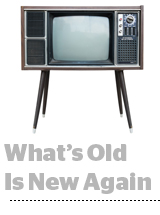 A spree of direct-to-consumer (DTC) brands, including Hubble, Bonobos and Rothy’s, have started running TV commercials. And aside from adding demand to the scatter market, those DTC companies are bringing digital-first measurement standards to the new (ahem … old) media channel.
A spree of direct-to-consumer (DTC) brands, including Hubble, Bonobos and Rothy’s, have started running TV commercials. And aside from adding demand to the scatter market, those DTC companies are bringing digital-first measurement standards to the new (ahem … old) media channel.
AdExchanger spoke with some top DTC brands about why they’re adding television to the media mix, and how a new data-driven perspective on TV campaigns is boosting TV advertising even as audience numbers diminish.
Why now?
DTC brands are outgrowing the social media nest. Facebook and Instagram ad rates jumped in the past year, and the cost per acquisition is rising even faster because the most targetable online audiences are saturated.
Transitioning to TV is an important step for DTC brands, to avoid being boxed into narrow audience segments on one or two social channels, Bonobos CEO Micky Onvural told AdExchanger last year, after the men’s fashion company ran its first TV campaign last year.
To be fair, DTC companies aren’t ditching digital media. It’s still the main user acquisition vehicle and gets most of the marketing attention, said Vivian Chang, senior director of marketing for the DTC food company Plated, owned the by the grocery chain Albertson’s. But TV has a “halo effect” that can boost search and social performance when online optimization starts to lose its edge.
The cost of entry for TV has also collapsed, making it easier for test-driven ecommerce marketers to try it out.
A few years ago, the minimum costs to produce a commercial was about $100,000, with another $500,000 guaranteed to start buying ad space, said Matt Gehring, VP of growth for Rothy’s, a DTC shoe manufacturer. Now a brand can realistically test TV ads for a tenth of that price.
Hubble, the DTC contact lens company, started running $100,000 TV campaigns, devoting half to produce four commercials and the other half on media, said CEO and co-founder Jesse Horwitz. That’s a large test budget compared to other media channels, where Hubble might spend $10,000 before deciding whether or not to commit.
“You can run TV at much lower scales than people have pitched historically, and sharper brands are adopting that to enters,” Horwitz said.
Testing TV in new ways
DTC brands are bringing a new testing and optimization ethos to television.
Hubble evaluates television campaigns by tracking organic searches and traffic to its site within five minutes of a commercial airing, as well as post-checkout surveys to see what percent of new customers remembered a TV ad, Horwitz said. With that baseline, the brand can move budgets up or down over time and see how the response rates change.
Older brands don’t have as strong testing instincts, using media mix modeling months after a campaign instead of running attribution within a week. But those brands also don’t have the same capacity to optimize TV campaigns, because they drive traffic to stores instead of to their own sites and apps.
The test-and-learn ethos also affects how DTC brands buy TV ads.
Television networks do most of their business in upfront sales. And traditional TV advertisers often buy a month or two of media before they measure or re-allocate spend.
But Rothy’s, which started its first television campaign last month, is buying TV on a quicker, more incremental cycle, Gehring said. The brand starts with networks or programs that skew toward young women and every week re-upping spend on the shows, days or day-parts that perform best.
Improving attribution
Television networks are concerned that attribution models favor digital channels, where audience data can be collected and tied to conversions. But the DTC attribution obsession is boosting TV as well.
The effective CPM for linear television inventory can be much lower than digital video or streaming, once a brand has established baseline metrics for how TV impacts site visitors and conversion rates, Chang said. Startup brands with strong online attribution tech are supporting higher prices for TV ads, she said.
Now that Hubble has attribution models that connect site traffic and sales to the cost per acquisition of TV audiences, Horwitz said the brand treats TV like a performance channel, where it can “spends as much as we want as long as the cost to drive traffic meets that CPA.”
Television is hard to scale up quickly, he said, because larger brands like Procter & Gamble can outspend or box out smaller competitors more effectively on TV than digital media.
But those legacy brands are using TV the same way they always have, Horowitz said, by buying gross ratings points to try and drive viewers to stores. “The premiums that are going up for TV inventory right now are driven by DTC brands and measurement, demonstrating value in other ways.”
This post was syndicated from Ad Exchanger.


More Stories
Warner Bros. Discovery CEO David Zaslav Receives $51.9 Million Pay Package for 2024
TikTok Fave Duolingo Boosts YouTube Shorts Viewership 430% in One Year
Streaming Ratings, Week of March 10: Disney+ Sails to the Top Courtesy of Moana 2